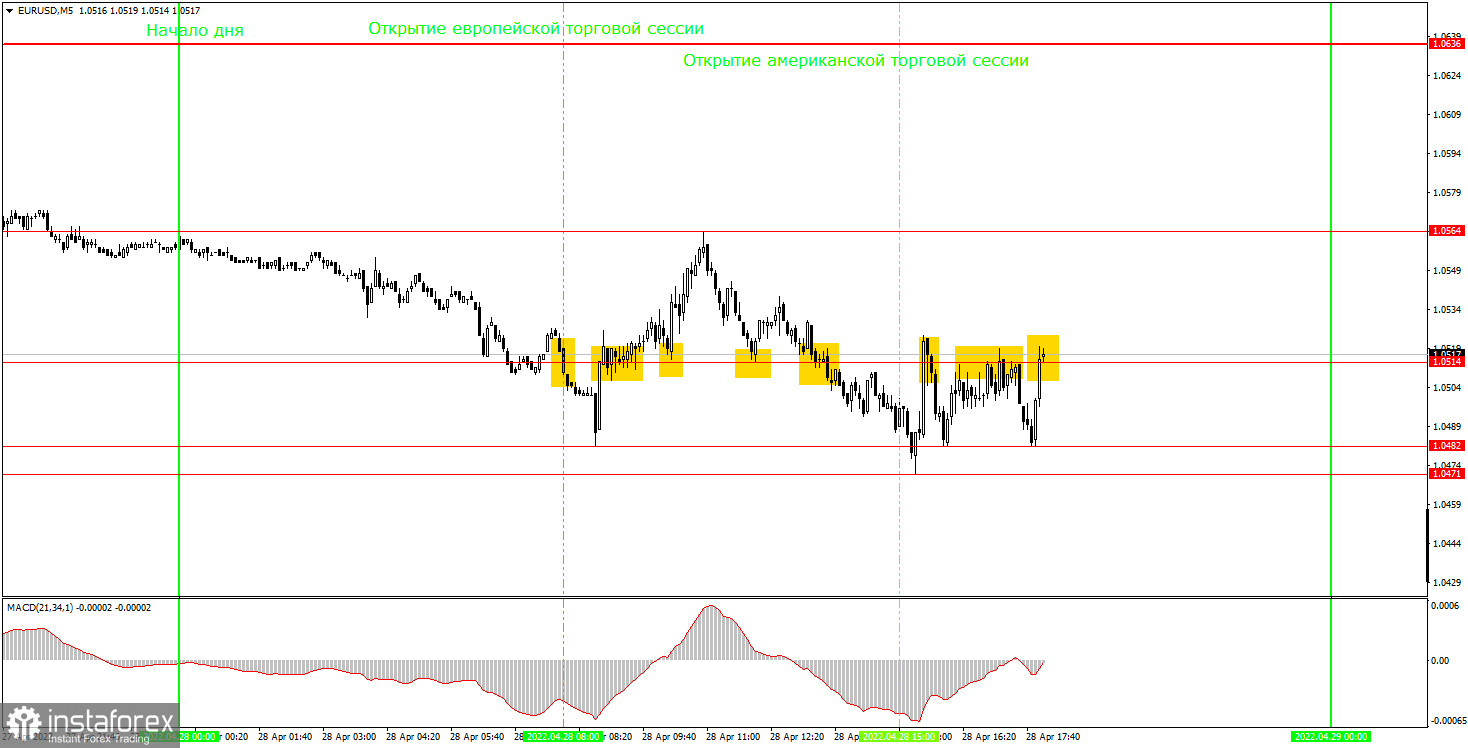Analyzing trades on Thursday:
EUR/USD on 30M chart

EUR/USD continued its downtrend on Thursday, moving within the boundaries of the descending channel which was not quite distinct. However, today the downtrend was less pronounced as bears are gradually losing momentum. The European currency lost 450 points in 6 days even though there was no macroeconomic or fundamental news and the geopolitical background was also quiet. The reports that were published this week have hardly caused any reaction in the market. The best example is the GDP report for the first quarter of 2022 in the US published on Thursday. Analysts expected to see a slight increase, but in fact, the US economy contracted by 1.4% compared to the previous quarter. This is not the final reading but it says a lot. First of all, it shows that the US economy may not be doing as well as we thought. However, this report did not cause a sell-off in the US dollar which is indeed an indicative moment.
EUR/USD on 5M chart

On the 5-minute time frame, the technical conditions were not so great as well. Although the euro depreciated by the end of the session, all trading signals that were formed emerged around the same level of 1.0514. And there were a lot of these signals, which means that the pair was trading flat in the European and North American sessions. Let's discuss how beginners should have traded the pair on Thursday. The first sell signal was formed at the very beginning of the session when the price settled below the level of 1.0514. After that, the quote managed to go down by 23 pips, so novice traders had to set a Stop Loss to breakeven, where the trade was eventually closed. Then a buy signal was formed, and the pair went up by 40 pips. Since there was only one level of 1.0636 above, this trade had to be closed manually, and it was possible to earn about 20-30 pips. Then a rebound from the level of 1.0514 served as another buy signal. This time, the pair managed to rise by only 16 pips, and the trade was closed at a Stop Loss. At this point, traders should have exited the market as two false signals had been formed by this time. They ended at a Stop Loss. All other signals had to be ignored. The levels of 1.0564 and 1.0471-1.0482 were the extremum points of the day.
Trading tips on Friday:
On the 30-minute time frame, the downtrend is prevailing which is clearly visible on higher time frames. The descending channel demonstrates very well what is happening now. Consolidation above this channel does not guarantee that the euro will rise. So far, it is rather difficult to say when the fall of the euro will end, but there are also some signs of a slowdown. On the 5-minute chart on Friday, it is recommended to trade at the levels of 1.0369, 1.0471-1.0482, 1.0514, 1.0564, and 1.0636. You should set a Stop Loss to breakeven as soon as the price passes 15 pips in the right direction. On Friday, the European Union will publish an important inflation report for April. The consumer price index is expected to accelerate again and reach 7.5%. A key report on GDP in the eurozone will also be published. In the US, only minor reports are expected on Friday.
Basic rules of the trading system:
1) The strength of the signal is determined by the time it took the signal to form (a rebound or a breakout of the level). The quicker it is formed, the stronger the signal is.2) If two or more positions were opened near a certain level based on a false signal (which did not trigger a Take Profit or test the nearest target level), then all subsequent signals at this level should be ignored.3) When trading flat, a pair can form multiple false signals or not form them at all. In any case, it is better to stop trading at the first sign of a flat movement.4) Trades should be opened in the period between the start of the European session and the middle of the US trading hours, when all positions must be closed manually.5) You can trade using signals from the MACD indicator on the 30-minute time frame only amid strong volatility and a clear trend that should be confirmed by a trendline or a trend channel.6) If two levels are located too close to each other (from 5 to 15 pips), they should be considered support and resistance levels.
On the chart:
Support and Resistance Levels are the levels that serve as targets when buying or selling the pair. You can place Take Profit near these levels.
Red lines are channels or trend lines that display the current trend and show in which direction it is better to trade now.
The MACD indicator (14, 22, and 3) consists of a histogram and a signal line. When they cross, this is a signal to enter the market. It is recommended to use this indicator in combination with trend patterns (channels and trendlines).
Important announcements and economic reports that can be found on the economic calendar can seriously influence the trajectory of a currency pair. Therefore, at the time of their release, we recommend trading as carefully as possible or exiting the market in order to avoid sharp price fluctuations.
Beginners on Forex should remember that not every single trade has to be profitable. The development of a clear strategy and money management is the key to success in trading over a long period of time.
 English
English 
 Русский
Русский Bahasa Indonesia
Bahasa Indonesia Bahasa Malay
Bahasa Malay ไทย
ไทย Español
Español Deutsch
Deutsch Български
Български Français
Français Tiếng Việt
Tiếng Việt 中文
中文 বাংলা
বাংলা हिन्दी
हिन्दी Čeština
Čeština Українська
Українська Română
Română

